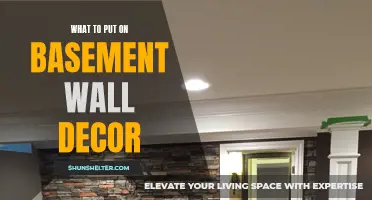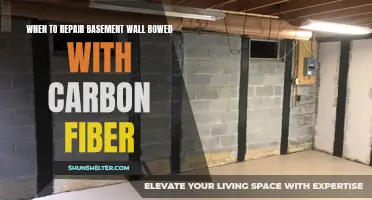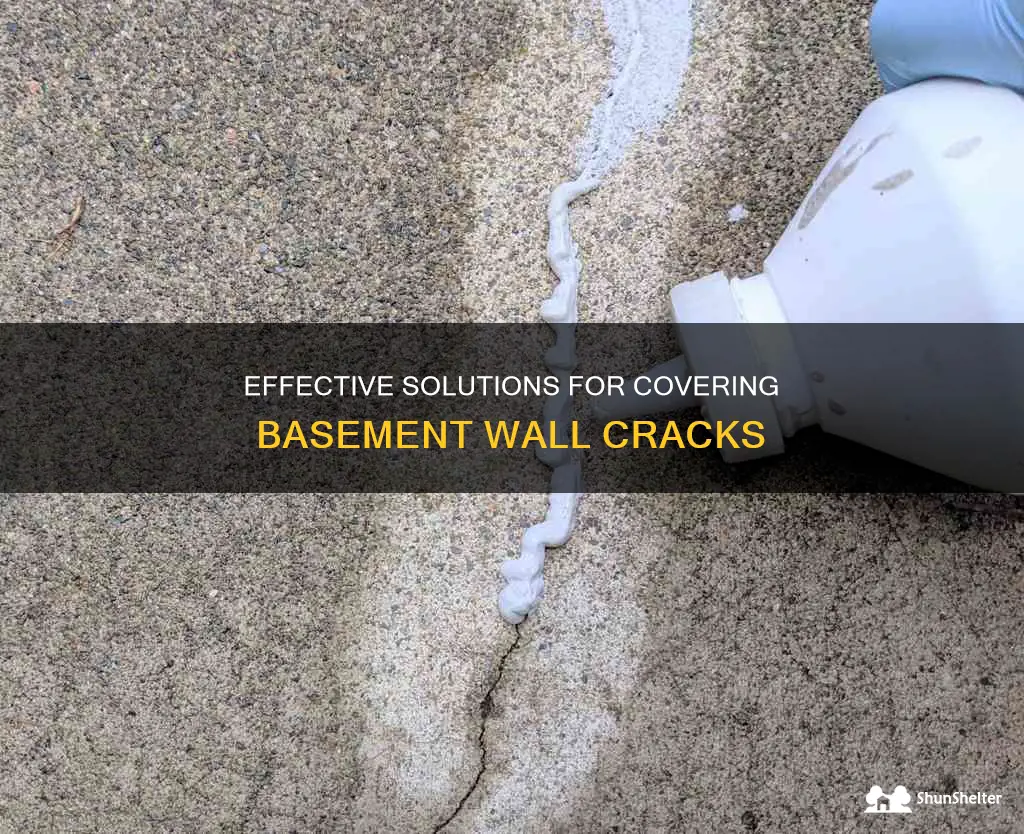
Basement wall cracks can be a major concern for homeowners, as they can lead to water infiltration, structural damage, and even compromised safety. As such, it is crucial to address these cracks promptly and effectively to prevent further issues. In this guide, we will explore various options for what to put over basement wall cracks, providing you with practical tips and advice on how to protect your home and maintain its integrity. Whether you are dealing with small hairline cracks or more significant fissures, we have you covered with tried-and-tested solutions that will help keep your basement dry and secure. So, let's dive in and discover the best ways to seal and reinforce those troublesome basement wall cracks!
| Characteristics | Values |
|---|---|
| Material | Epoxy injection |
| Application | Fill and seal cracks |
| Durability | Long-lasting and permanent solution |
| Flexibility | Can withstand structural movements |
| Water resistance | Provides a waterproof barrier |
| Strength | Enhances the structural integrity |
| Appearance | Minimal intrusion and seamless finish |
What You'll Learn

Importance of covering basement wall cracks to prevent further damage
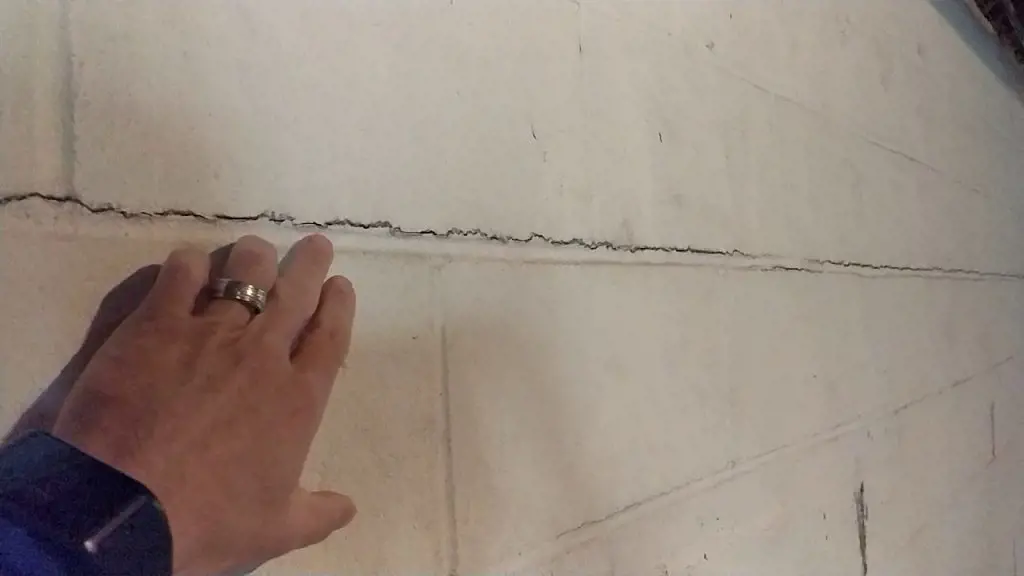
Basement wall cracks are a common occurrence in many homes. They can be caused by a variety of factors such as settling, moisture, or even hydrostatic pressure from the soil surrounding the foundation. While small cracks may seem harmless, they can actually lead to larger structural issues if left untreated.
One of the most important steps in preventing further damage to your basement walls is to cover these cracks. By doing so, you can effectively seal them off from moisture and prevent them from widening over time. This will not only protect the structural integrity of your foundation but also help to maintain a dry and comfortable living space in your basement.
Here are some materials that you can use to cover basement wall cracks and prevent further damage:
- Epoxy injections: Epoxy is a strong and durable material that can be used to fill and cover basement wall cracks. It is easy to apply and can effectively seal off the cracks, preventing moisture from seeping in. Epoxy injections are especially recommended for narrow cracks that are less than a quarter-inch wide.
- Polyurethane sealants: Polyurethane sealants are another popular choice for covering basement wall cracks. They are flexible and can accommodate minor shifts in the foundation without cracking. Polyurethane sealants also have excellent adhesion properties and can create a watertight seal, preventing water infiltration.
- Hydraulic cement: Hydraulic cement is a quick-setting material that can be used to fill larger cracks in basement walls. It expands as it sets, ensuring a tight seal and preventing water leakage. Hydraulic cement is particularly suitable for cracks that are actively leaking or where water pressure is an issue.
- Injection foam: Injection foam is a type of expanding foam that can be injected into cracks to provide insulation and moisture resistance. It expands and hardens, creating a solid barrier that can seal off the crack. Injection foam is an effective solution for both small and large cracks, as it can expand to fill any voids.
Before applying any of these materials, it is important to prepare the crack by cleaning it thoroughly. Remove any loose debris or dirt using a brush or vacuum cleaner to ensure proper adhesion. You may also need to widen the crack slightly to create a better surface for the chosen material to adhere to.
Once the crack is clean and prepared, follow the manufacturer's instructions for applying the chosen material. Most products will require you to mix or activate the material before using it. Use a putty knife or caulking gun to apply the material, ensuring that it fills the entire crack and creates a smooth surface.
By covering basement wall cracks with the appropriate materials, you can effectively prevent further damage to your foundation. Regularly inspect your basement walls for new cracks or signs of moisture to catch any issues early on. Remember, addressing small cracks now can save you from more significant and costly repairs in the future.
Mastering the Art of Tuck Pointing Basement Walls
You may want to see also

Types of materials that can be used to cover basement wall cracks
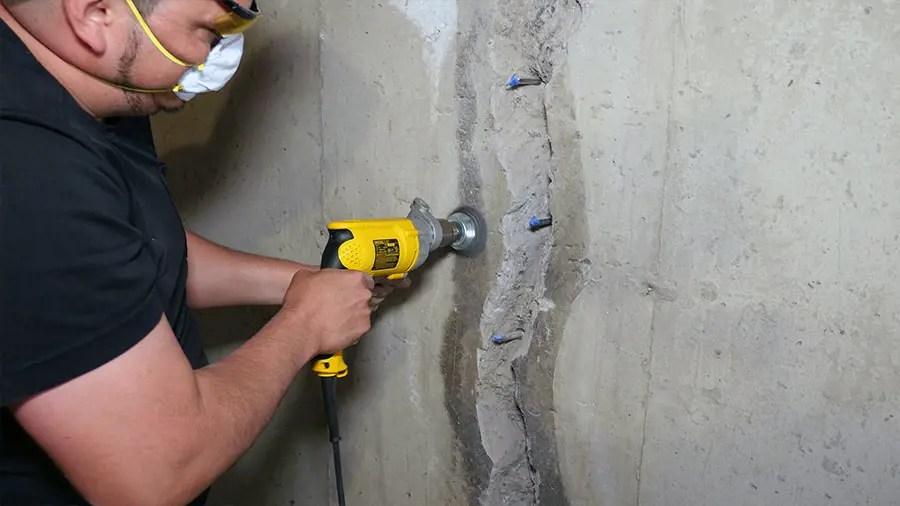
Basement wall cracks can be a common issue for homeowners, but fortunately, there are several materials that can be used to cover these cracks and prevent further damage. Whether you are looking for a temporary solution or a more permanent fix, there are options available to suit your needs. In this blog post, we will discuss the different types of materials that can be used to cover basement wall cracks.
- Epoxy Injection: Epoxy injection is a popular method used to repair cracks in basement walls. This material is a two-part epoxy compound that is injected into the crack, filling it from the inside out. Epoxy has excellent adhesion properties and can effectively bond with concrete, making it an ideal choice for repairing cracks. It also has the added benefit of being waterproof, which helps to prevent further damage to the wall.
- Hydraulic Cement: Hydraulic cement is another material commonly used to cover basement wall cracks. This type of cement sets and hardens quickly when exposed to water, making it an ideal choice for sealing cracks that may be leaking. To apply hydraulic cement, simply mix it with water to create a slurry and then press it into the crack. The cement will expand as it cures, creating a watertight seal.
- Concrete Patching Compound: If you are looking for a more permanent solution, concrete patching compound can be used to cover basement wall cracks. This material is specifically designed to repair and fill cracks in concrete surfaces. To use this compound, clean the crack thoroughly and apply the patching compound with a trowel, making sure to smooth it out evenly. Once the compound has dried and cured, it can be painted or sealed to match the surrounding area.
- Drywall Tape and Joint Compound: For smaller cracks in basement walls, drywall tape and joint compound can be used to cover and repair the area. First, apply a layer of joint compound to the crack, making sure to press it into the wall with a putty knife. Next, place a strip of drywall tape over the joint compound, pressing it firmly into place. Finally, apply another layer of joint compound over the tape, feathering the edges to create a smooth finish. Once the compound has dried, sand the area and apply primer and paint as desired.
- Vinyl Wall Covering: If you are looking for a temporary solution or simply want to cover up unsightly cracks, vinyl wall covering can be used to hide basement wall cracks. Vinyl wall covering is easy to install and can be cut to fit the specific dimensions of the wall. Simply apply adhesive to the back of the vinyl and press it firmly against the wall, making sure to smooth out any wrinkles or bubbles. Vinyl wall covering is available in a wide range of colors and patterns, allowing you to customize the look of your basement.
In conclusion, if you are looking to cover basement wall cracks, there are several materials available to suit your needs. Whether you opt for a more permanent solution like epoxy or concrete patching compound, or a temporary solution like vinyl wall covering, it is important to address cracks in basement walls as soon as possible to prevent further damage. By using these materials, you can effectively cover cracks and protect your basement from water damage and structural issues.
Understanding the Causes of Lime Buildup on Basement Walls and How to Prevent It
You may want to see also

Steps to properly cover basement wall cracks for a long-lasting solution
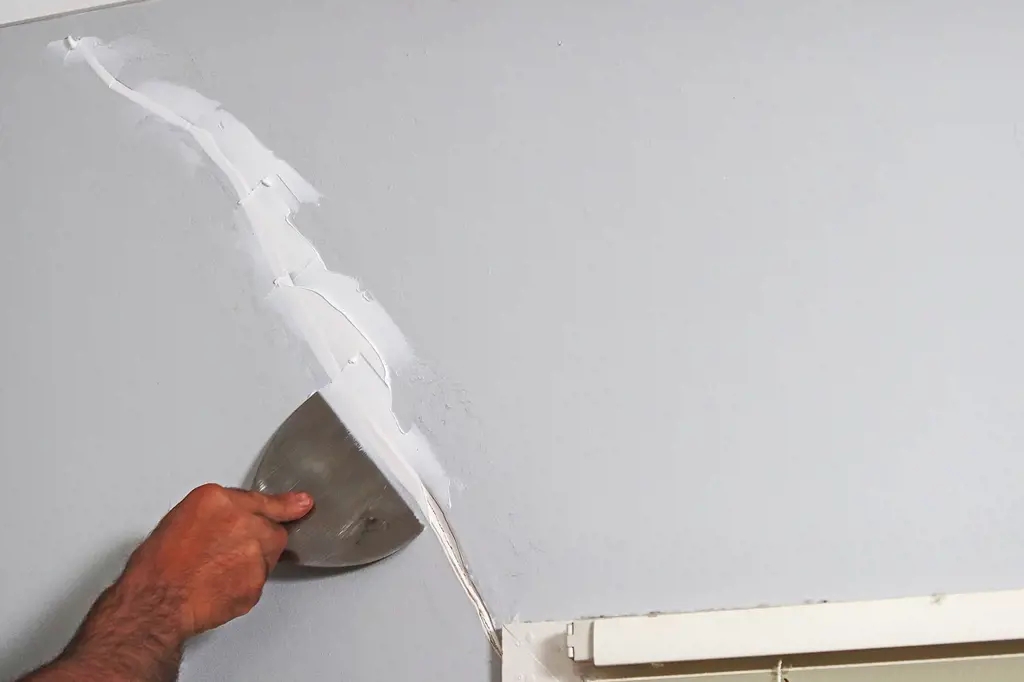
Basement wall cracks can be a common problem in many homes. These cracks can be caused by a variety of factors, including settling of the foundation, water pressure, or even poor construction. Regardless of the cause, it is important to properly cover basement wall cracks to prevent further damage and ensure the long-term stability of your home. Follow these steps to properly cover basement wall cracks for a long-lasting solution.
Step 1: Assess the crack
Before you start covering the crack, it is important to assess its size and severity. Small, hairline cracks can usually be repaired with simple DIY methods, while larger cracks may require professional help. To determine the severity of the crack, use a flashlight to inspect both the interior and exterior of the wall. If the crack is wider than a quarter-inch, or if it is accompanied by other signs of damage such as bulging or bowing of the wall, it is best to consult a professional.
Step 2: Clean the area
Once you have determined that the crack is not too severe, the next step is to clean the area around the crack. Use a wire brush or a scraper to remove any loose debris, dirt, or old paint from the surface. This will ensure that the covering material adheres properly to the wall.
Step 3: Apply a filler
To cover the crack and prevent any further water penetration, you will need to apply a filler. There are multiple options available for filling basement wall cracks, including epoxy, polyurethane, or hydraulic cement. Each of these materials has its own advantages and disadvantages, so it is important to choose the one that best suits your needs. Follow the manufacturer's instructions to properly mix and apply the filler. Use a putty knife or a trowel to spread the filler over the crack, making sure to completely cover it.
Step 4: Smooth and level the surface
Once the filler is applied, use a putty knife or a trowel to smooth and level the surface. This will ensure that the covering material adheres properly and creates a seamless finish. If necessary, add more filler to any low spots or uneven areas.
Step 5: Allow the filler to dry
After applying the filler, allow it to dry completely. The drying time will depend on the type of filler you used and the manufacturer's instructions. It is important not to rush this step, as premature drying can lead to cracking or a weak bond. Follow the recommended drying time and avoid touching or disturbing the area during this period.
Step 6: Paint or finish the wall
Once the filler is completely dry, you can paint or finish the wall to blend it with the rest of the basement. Use a waterproof paint or a sealant to provide an additional layer of protection against moisture. This will help to prevent future cracks and ensure the longevity of your repair.
In conclusion, properly covering basement wall cracks is essential for maintaining the stability and integrity of your home. By following these steps and using the right materials, you can effectively cover basement wall cracks and prevent further damage. If you are unsure about the severity of the cracks or if you are uncomfortable performing the repairs yourself, it is always best to consult a professional. They will be able to assess the situation and provide you with the most appropriate solution for your basement wall cracks.
The Ultimate Guide to Supporting Walls When Digging a Basement
You may want to see also

Common mistakes to avoid when covering basement wall cracks
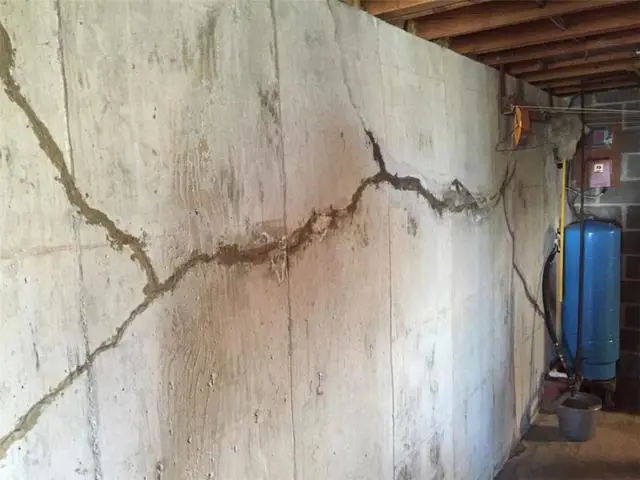
If you have noticed cracks in your basement walls, it’s important to address them as soon as possible to prevent further damage. One common mistake that homeowners make when covering basement wall cracks is not addressing the underlying cause of the cracks. Simply covering up the cracks without fixing the root problem can lead to recurring issues in the future. Here are some common mistakes to avoid when covering basement wall cracks:
- Ignoring the Cause: Before you cover up the cracks, it’s essential to determine the cause of the cracks. The cracks may be a result of foundation settlement, water pressure, or other structural issues. If you don't address the underlying cause, the cracks may reappear or worsen over time. Consider consulting a professional to assess the cause of the cracks before proceeding with any repairs.
- Using Inadequate Materials: Choosing the right materials to cover basement wall cracks is crucial. Using ineffective or low-quality materials can lead to a temporary fix that will need repairing again in the future. Make sure to use a high-quality epoxy or polyurethane injection to fill the cracks, as these materials provide stronger adhesion and flexibility.
- Not Preparing the Surface: Before applying any sealant or filler, it’s important to prepare the surface properly. Clean the cracks thoroughly, removing any loose debris, dust, or paint. Use a wire brush or scraper to create a clean and smooth surface to improve the bond between the wall and the sealant.
- Applying Too Much Filler: While it may be tempting to fill the cracks excessively, applying too much filler can cause the material to bulge or crack under pressure. It’s important to follow the manufacturer’s instructions and apply the correct amount of filler to ensure a proper seal.
- Neglecting Waterproofing: In many cases, basement wall cracks are caused by water seepage. If you only cover the cracks without addressing the water issue, the cracks may recur due to hydrostatic pressure. Along with filling the cracks, consider waterproofing the basement walls to prevent future water intrusion.
- Not Considering Professional Help: While minor cracks can often be fixed by homeowners, more extensive cracks or structural issues may require professional assistance. If you are unsure about the severity or cause of the cracks, it’s advisable to consult a structural engineer or a foundation repair contractor. They will be able to assess the situation and provide appropriate recommendations for repair.
In conclusion, covering basement wall cracks should not be taken lightly. Avoid these common mistakes to ensure a long-lasting repair. Address the underlying cause of the cracks, use high-quality materials, prepare the surface properly, apply the correct amount of filler, and consider waterproofing the basement walls. And if in doubt, don’t hesitate to seek professional help. By taking these steps, you can effectively cover basement wall cracks and protect your home from further damage.
Understanding the Common Causes of Basement Foundation Wall Cracks
You may want to see also
Frequently asked questions
For small cracks in basement walls, you can use a high-quality, waterproof caulking compound.
Regular paint may not be sufficient to cover basement wall cracks. It is recommended to use a paint specifically designed for masonry or basement walls, as it will have better adhesion and durability.
Joint compound is typically used for filling in cracks and gaps in drywall, not in basement walls. It is best to use a product specifically designed for repairing concrete or masonry surfaces.
Yes, it is crucial to waterproof basement wall cracks before covering them. Moisture can seep through the cracks and cause further damage, such as mold growth or structural issues. Use a waterproofing sealant or primer before filling in the cracks to prevent future problems.



